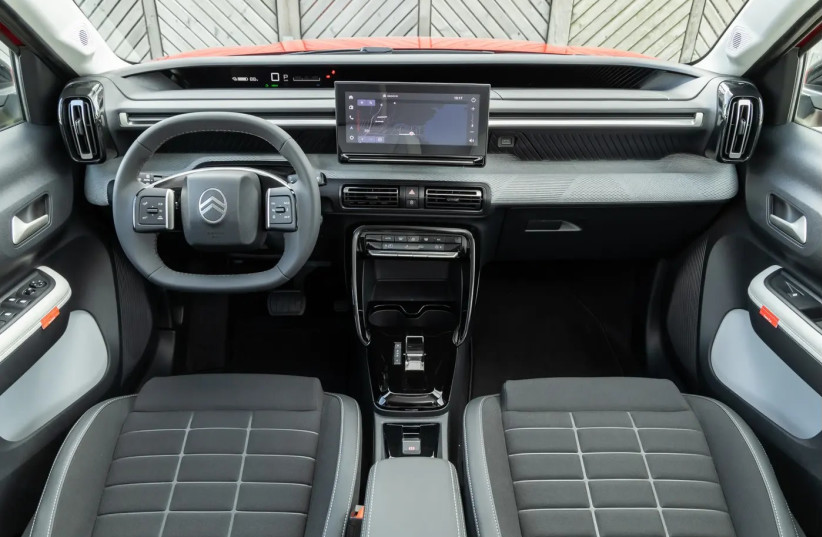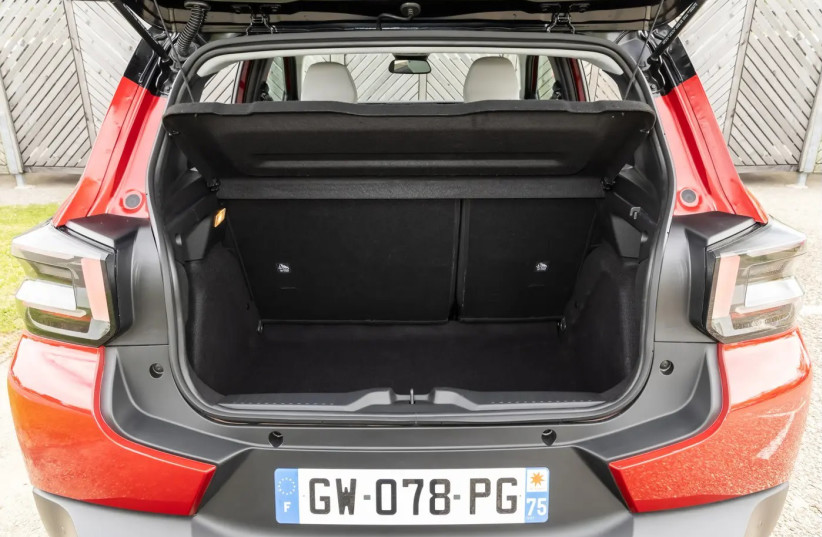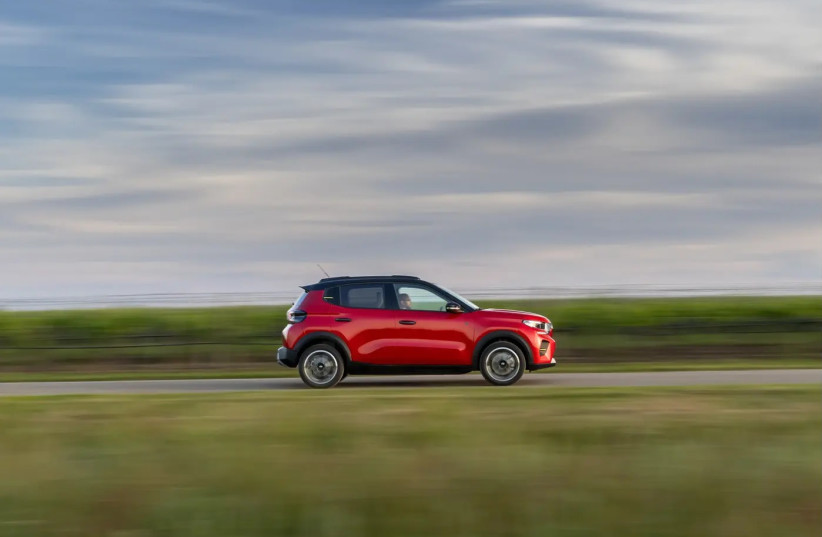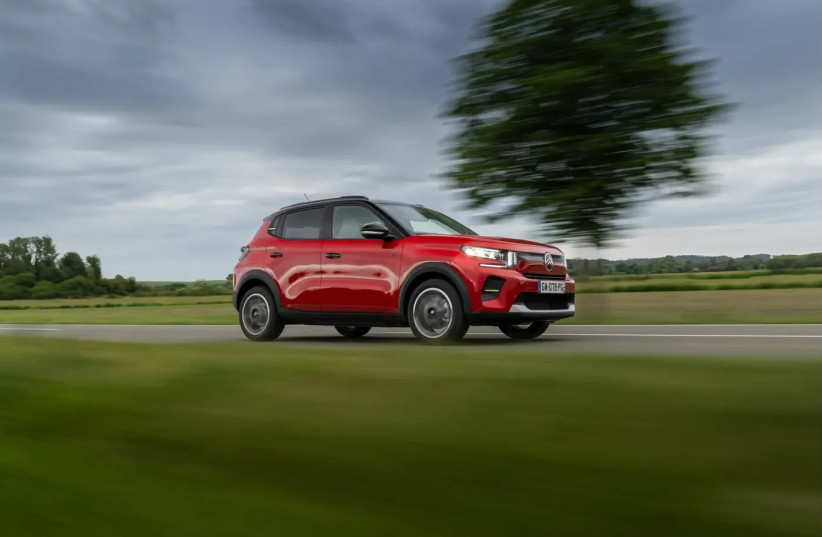Estimated Price: NIS 120,000-130,000
Competitors: Dacia Spring, Fiat 500e
Liked: Expected price, comfortable ride, spacious interior, design and practicality
Disliked: Average performance, rear seat and accessibility, relatively short range
There is only one Citroen that has sold more copies than its mythical DS. The supermini C3 has sold 5.6 million cars since its launch, compared to the DS which sold 5.1 million between 1948 and 1990. Its simplicity, affordability, and efficiency kept it on production lines for 42 years, initially as a cheap transportation vehicle, and later, also nostalgic.
Now, in its fourth generation, the French are taking the C3 in the same direction. After the automotive industry, mainly Tesla and the Chinese, accustomed us to the idea that an electric car must accelerate from 0 to 100 km/h in less than 6 seconds, be equipped up to the panoramic roof with giant screens, leather upholstery, massage seats, and cost - accordingly to all these, Citroen comes and says: "Alright! These prices are impossible, especially not when the Chinese are already knocking on the door."
The new C3 is designed to be as accessible as possible and appeal to as many types of customers as possible. It is still defined as a supermini, but its height is 10 cm higher, and now it looks a bit like a jeep. It will also be produced with a light and economical hybrid gasoline engine, as well as an affordable electric version. Based on this, next year a new C3 Aircross will also be offered, with an interesting option for seven seats.
In other words, Citroën is going to compete with Dacia for value for money. In days of global economic struggle and climate crisis, this is not a bad idea at all. The question is how it will perform.
Design: The fourth generation dimensions are almost identical to those of the outgoing model: length - 4.01 meters, width - 1.76 meters, and height of 1.54 meters indicate that the new C remains compact in size, and has grown, mainly in height with an additional 10 cm. The wheelbase, which stretches to 2.54 meters, is exactly the same as the previous model, but the ground clearance has increased from 13.5 cm to 16.3 cm (in the electric version) and even to 19.5 cm in the gasoline version.
On the same base, the Fiat Grande Panda and Opel Frontera will be launched next year. In contrast, Citroën has received a slightly more rounded and less rugged design, aiming for a more sophisticated look, with a front end identified with the new brand design language. At the front and rear, the new elliptical logo of Citroën is elegantly embedded.
Driving environment: The small steering wheel allows the driver to see over it into the narrow and minimalist dashboard located in the driver's line of sight. Citroën tries to market it as an overhead display, but we will leave this name just for display on the front windshield. The C3 has a small and efficient screen that the steering wheel does not hide, providing the basic and necessary information to the driver.
The dashboard is horizontal and flat and includes, as an optional feature, a 10.25-inch multimedia screen. Separately, there is an independent physical control system for the climate control, with the main air conditioning vents located low, below the screen, and they direct the cool air to the driver's side, not in front of it.
The driving posture is upright, and the seat also has height adjustment. The edges of the horizontal and flat engine cover can be distinguished, contributing to better maneuverability, especially in the city. The steering wheel adjustments, mostly for height and less for depth, allow for relatively precise adjustment. Taller drivers may complain about the right knee being too close to the central console, but the comfortable and supportive front seats compensate for this to some extent and agree with us on the relatively high score for the driver's environment.
Passenger compartment and spaciousness: The new C3, although relatively to the model it replaced, only lengthened by 19 mm and widened by only 6 mm, certainly achieves a more improved space for passengers. The high roof structure allows designers to place the seats so that both legroom in the front and rear is improved - a blessed improvement, especially compared to the cramped space in the outgoing model.
Improved headroom and wide field of view allow for good visibility - a blessed fact, especially when it comes to an urban-oriented car. Thanks to significantly improved headroom compared to the outgoing model, improved legroom and large windows, the rear seating area is considered quite reasonable. It is important to note that the rear seats are not at the same level as the front seats, being low and short. Accessing and exiting them requires flexibility, especially for an adult - things that deduct quite a few points from the new C3.
The unique fabric upholstery in the passenger compartment fails to cover up noticeable savings. Whether it is evident in the quality of materials here and there, the lack of the ability to adjust the seatbelt height, the absence of rear interior lighting, or the roof handles.
The cargo space volume (currently standing at 310 liters) is 10 liters larger than that of the previous model, and the folding rear seats (in a 60/40 split) although not creating a continuous surface with the floor, allow for carrying larger loads. On the other hand, the high loading threshold will force you to lift tall items before placing them on the cargo floor.
Equipment: There are two levels of finish: The base level YOU comes with LED headlights, but with a smartphone holder that serves as a multimedia screen and navigation, manual air conditioning, parking sensors, and electric mirrors. The goal: to provide a super competitive price in Europe, starting from €15,000 for the manual version and €23,600 e for the electric one.
The MAX level, with an additional €4,000 in Europe, includes, in addition, two-tone paint with a contrasting roof color, decorative roof rails, 17-inch alloy wheels with diamond cut, LED taillights, tinted rear windows, a colorful 10.25-inch touchscreen, comfortable seats, folding rear seats (in a 60/40 split), climate control, wireless charging for mobile devices, rear camera, electrochromic rearview mirror, electric rear windows, electric folding exterior mirrors, automatic wipers, and more.
Safety: There are 6 airbags, autonomous emergency braking, lane departure warning, speed limit sign recognition, and electric parking brake. However, there are no blind spot warnings in the mirrors and adaptive cruise control.
Engine and performance: The electric version we drove is equipped with a front motor with 113 kW, and when it comes to an electric car, this figure is not impressive. Acceleration to 100 km/h takes 10.4 seconds, which is no longer impressive nowadays, and certainly not with a maximum speed limited by a computer to 135 km/h. Will this affect quick urban driving or compromise safety on highways? No.
The handling response is reasonable from a safety aspect, and maneuvering around semi-trailers on intercity two-lane roads was possible without difficulty, although it required planning and greater safety precautions than those we are accustomed to in electrically powered cars.
Regenerative braking exists in two levels, with the default being the higher one that does not allow for one-pedal driving. The combined official travel range with a 44 kWh battery stands at 326 km, while fast charging (100 kW) will allow you to charge the battery from 10% to 80% in about half an hour. Slow charging will be done at a rate of up to 7.4 kW.
The C3 will also be marketed with a 1,200 cc turbo-petrol engine, 3 cylinders, producing 100 hp in a manual version, and the same power unit with an additional 28 hp electric motor, in an automatic version with a dual-clutch gearbox, 6 gears. After troubles with the timing belt that broke in current 1.2 models of Peugeot-Citroën and Opel, the new C3 has switched to a more reliable timing chain.
We managed to steal a short drive on the manual version. The relatively powerful engine, relatively high ground clearance allowing for off-road driving, and the fuel-efficient consumption raise hope that it will also reach the country. The price in Europe for the manual version with a YOU finish hints at a possible Israeli price of NIS 90,000 for a 3-pedal version, which will be one of the cheaper cars in the country, especially considering its size.
Comfort and behavior: We arrived here with expectations. We already know the progressive shock absorber system from the larger siblings of the 3 series, and here too – it did not disappoint. Above-average cushioning and insulation in the category make the small Citroën one that is pleasant to be in, even on long trips. The noise insulation in the electric car was found to be quite good, and every now and then when talking about a car defined as cheap.
The light feeling, powerful brake pedal feel, natural sensation, small turning radius (10.6 meters), and confident behavior even at relatively high speeds make the car very easy to drive. This does not mean that it is a French supermini that car enthusiasts will worship, as the softness and height of the car create rolling angles under load and the feeling is not communicative when it comes to such a driving style.
Bottom line: Despite the Citroen C3 being a beloved and successful supermini that has known how to combine, especially in design and comfort and has been well sold, this time, Citroen's direction is slightly different. Its goal is to conquer the popular category in Europe with electric propulsion at an attractive price, starting at €23,000 for the YOU version, and later to a €20,000 version with a smaller battery and shorter range.
Stylish design and technology, decent equipment, and the familiar Citroen comfort will try to compensate for the modest performance and efficient passenger compartment, but not indulgent. However, the results of the new Citroen's battle against other electric vehicles will mainly be decided by the price that has not yet been determined. According to the price in Europe, one can expect NIS 120,000-130,000 if it manages to arrive in the country as planned later this year, before the next increase in the purchase tax on electric vehicles.
The writer was a Citroen e-C3 guest in Austria.
Citroen e-C3: On the technical side
Engine: Electric: 113 hp, 12.2 kg/m
Transmission: Auto direct transmission, front-wheel drive
Electric:
Battery: 44 kWh
Slow charging rate: 7.4 kW
Fast charging rate: 100 kW
Dimensions:
Length (m): 4.015
Width (m): 1.755
Height (m): 1.57
Wheelbase (m): 2.54
Cargo volume (liters): 310
Weight (kg): 1,416
Performance (manufacturer's data):
0-100 km/h (seconds): 10.4
Maximum speed (km/h): 135
Combined range (km): 326
Test drive range: not measured
Safety:
European crash test: not tested yet
Active safety: autonomous emergency braking, lane departure warning and correction, obstacle detection
Warranty:
5 years or 120,000 km for the vehicle, 8 years or 160,000 km for the battery





